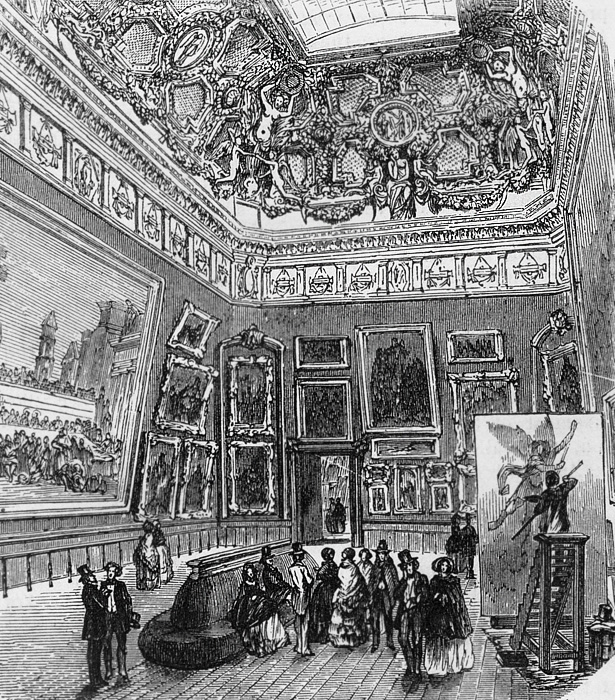The Salon
David W. Galenson and Robert Jenson, "Canvases and Careers: The Rise of the Market for Modern Art in the Nineteenth Century"
| As you read the description of the mechanics of the 19th century Paris art world, ask yourself how operating in an environment like this would predispose artists like Gérôme to hold to the artistic forms of the past and resist innovations. |
- In what ways were the attempts to change French art limited by the institutions within which artists operated?
- What kinds of art were be favored by this system and what kinds discouraged?
- What arguments might the defenders of this system advance to justify the roles of the Academy, the Salon, the Ecole des Beaux Arts, and the awards given to artists?
- In what ways did this system support the work of those artists that it favored? Why should those were successful within this system defend tradition?
- What was apt to happen to a young artist who tried to take art in a radical new direction?
The Academic system was controlled by the government’s Academie de Peinture et Sculpture [Academy of Painting and Sculpture](hereafter the Academy). Aspiring artists were educated at the government's École des Beaux-Arts [School of Fine Arts], where they were taught to use traditional methods to emulate the work of their teachers. While at the Ecole students advanced if they passed annual examinations and participated in a series of contests designed to identify the most talented. After graduation the goal of young artists was to display their paintings at the Salon, the great annual or biennial exhibition that was the French art world"s principal showcase for new work.
educated at the government's École des Beaux-Arts [School of Fine Arts], where they were taught to use traditional methods to emulate the work of their teachers. While at the Ecole students advanced if they passed annual examinations and participated in a series of contests designed to identify the most talented. After graduation the goal of young artists was to display their paintings at the Salon, the great annual or biennial exhibition that was the French art world"s principal showcase for new work.
Admission to the Salon was regulated by a jury. Although its composition varied, a majority of the jury’s members were usually associated with the Academy. The Academy consequently used the Salon as a continuing means of control over artists: not only acceptance of their paintings but preferential placement of their work in the many crowded halls of the Salon, and access to themedals that the jury awarded to recognize distinction were all central to building the reputations that would create a demand from private clients for the artists' work.
The Paris Salon, unlike comparable institutions in other Western nations, dominated its nation’s art until at least the third quarter of the century. This occurred not because there was an absence of rival exhibition venues. Rather both artists and their publics sustained the belief that the Salon was the only truly legitimate arena tor exhibiting and evaluating works of art. So deeply did the Parisian art world hold to the certifying function of the Salon that this faith survived the many controversies over the judgment of Salon juries, over who voted for the juries, and over who served on them.
Until 1874, showing at the Salon was a necessary condition for establishing an artist’s reputation and career in Paris. Thus no major French artist was able to forego showing at the Salon, at least at the beginning of his or her career, until the last quarter of the century.